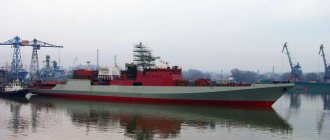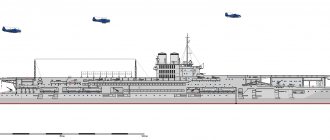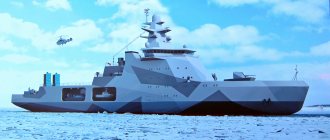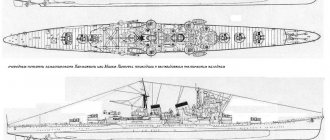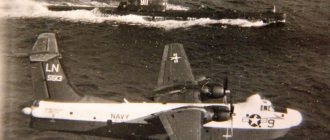After the collapse of the Soviet Union, all the efforts of the creators of unique warships, which were capable of wiping small states off the face of the earth, came to naught. At the turn of the 90s, the shipbuilding industry in Russia, like the armed forces, was undergoing enormous difficulties. During the entire restoration of the country, the ships already in service with the Russian fleet were not even modernized. Reviving the previous practice of building ships with enormous capabilities and rejuvenating the Black Sea Fleet has become important in the current difficult conditions. It is planned to return the Russian fleet to its former glory through the implementation of projects 22350 and 11356.
Vessels for the Black Sea Fleet
A completely different situation has developed with the ships of Project 11356. Russian industry has already mastered these frigates. Six ships manufactured at the Baltic Shipyard are successfully used in the Indian Navy.
It was decided that in the Russian Navy, Project 11356 vessels will serve in the Black Sea and adjacent waters. The main tasks of these ships will be to demonstrate the St. Andrew's flag, participate in anti-piracy activities, as well as carry out defensive and strike missions. The lead patrol frigate of Project 11356 “Admiral Grigorovich” has become a symbol indicating the return of the titan ships to service.
Projects 1155 and 11351
As a result, the introduction of a helicopter hangar resulted in the creation of the Project 1155 BOD, the construction of which was carried out by two Baltic shipyards. The Kerch shipyard began producing modernized patrol boats of Project 11351, which were planned to be handed over to border guards.
The presence of a helicopter made it possible to search and pursue border violating vessels. The stern was cleared to accommodate the hangar. In this regard, the shipbuilders moved one AK-100 to the bow of the ship. As a result, the number of air defense systems and artillery mounts with a caliber of 100 mm was halved. To protect the ships from air attacks, a pair of six-barreled AK-630 assault rifles with a caliber of 32 millimeters was installed at the stern. New hydroacoustics were also installed. In some of the ships built within the framework of Project 11351, the Angara radar system was replaced with the newest one, Fregat-M2.
All this allowed the ships of Project 11351 to outperform ships of previous projects.
What is a “watchman”?
The lead patrol frigate 11356 “Admiral Grigorovich” received its name in honor of Admiral I.K. Grigorovich, who was the Russian Minister of Navy from 1911 to 1917.
Work on the creation of this vessel began in December 2010 at the Yantar slipway in Kaliningrad under serial number No. 01357. In April 2015, frigate 11356 Admiral Grigorovich was ready for testing. This ship was tested until the end of that year. In 2016, after the signing of the acceptance certificate and the raising of the naval flag, frigate 11356 “Admiral Grigorovich” was officially put into service with the Russian Navy. Today it is assigned as a surface patrol ship to the 30th Division of the Black Sea Fleet.
Disadvantages of project 11357:
- The frigate’s 12 anti-ship missiles will not be adequate for its displacement ( the large 500-ton boat of Project 12248 “Molniya” is armed with 16 Uran anti-ship missiles; by the way, in the latest modification the range of the Kh-35UE is 260 kilometers).
- The lattice metal mast and the same support for the radar do not meet modern requirements for stealth in the radar range.
- The frigate's anti-submarine and anti-torpedo defense systems are overweight and have lower performance characteristics compared to new types of weapons (DTA-53-11356 torpedo tubes + 4 units of SET torpedoes of 533mm caliber + RBU-6000, adopted for service in 1961).
- Most likely, the Shtil-1 air defense system with a VPU (24 cells) will be installed. The Shtil-1 missile is heavier than that of the Redut air defense system and is less advanced.
Tests
During the inter-fleet transition to Sevastopol (May-June 2016), Admiral Grigorovich was used to detect “enemy” submarines as part of mandatory tests.
In the Black Sea, this frigate conducted artillery firing at a towed special shield. Shooting was also carried out at targets that were dropped onto the water by aircraft. The seaport in Novorossiysk became the place where this frigate took part in the 2016 Sea Cup competition. In August, the ship underwent training exercises to eliminate enemy submarines. The submarine "Rostov-on-Don" was used as an enemy. The ship took part in the “Russian Week on the Ionian Islands” (public forum).
In November 2016, the Admiral Grigorovich left the port of Sevastopol and headed for the Syrian shores. The mission of the frigate is to strengthen the Russian Navy in the Mediterranean.
Delivery of order
The first frigate 11356 was delivered in the spring of 2003, three months later the second was commissioned, and in 2004 the third.
India began operating the ships. Although the tests revealed minor compatibility issues with some weapon systems, Indian customers praised the potential of the 11356 frigate.
The successful implementation of the first order was followed by a contract for three more frigates. The ships were built according to a modified project 11356M. Now the ships were equipped with ultra-fast BrahMos anti-ship missiles, developed jointly by Russian and Indian specialists, instead of the Club system. The customer received the ships of the new project in 2012-2013. Repairs of frigates 11356 in India are carried out by the Russian side.
Protection
“Admiral Grigorovich” is the most protected frigate of Project 11356. The photo presented in the article shows the general appearance of the vessel. The frigate’s protection is provided by Shtil, an anti-aircraft missile system. In the event of a threat, the missiles of this air defense system are the first to engage in combat.
According to experts, educational or training events with the participation of a frigate are no different from combat ones. In order to intercept a target both during training and in a combat situation, the frigate crew is given only a few seconds.
Differences from the prototype
Soviet border guards used Project 11351 ships for patrol purposes and to combat poaching in the coastal waters of the USSR.
Therefore, it had almost no anti-ship weapons. The Indian customer needed a universal ship that could withstand any enemy. Thus the frigate Project 11356 was born. Almost all of the ship’s weapons were replaced. The Osa-M air defense system was replaced by Shtil-1. Launchers for Club anti-ship missiles have appeared. The medium-caliber artillery was updated - the A-190E 100 mm gun mount appeared.
When it comes to hydroacoustics, the Indians preferred the Humsa APSON system. All frigate equipment is controlled by the Requirement-ME system.
There are also significant differences in appearance. The frigate pr. 11356 has less visibility for radars. Deck buildings, based on the experience of past wars, are made of steel, not aluminum. Aluminum has shown low resistance to fires.
Control system
Automation of the vessel "Admiral Grigorovich" is provided using the BIUS management system. This information system processes data on bearing, range, course and speed of the target using high-performance computing systems.
The BIUS is considered the best in the world, since it is capable of not only processing data, but also controlling the ship’s weapons. The system reflects the rapidly changing tactical situation in combat conditions. Data collection, processing and display are carried out automatically. Next, the converted information is received by the ship's navigation and weapon system. Thus, the frigate can conduct combat operations either in operational connection with the Navy or independently.
Technical characteristics of the patrol ship "Admiral Essen"
The frigate "Admiral Essen", despite its small size, has powerful technical characteristics. The length of the patrol boat is 124.8 m, width - 15.2 m, the draft of the vessel is 4.2 m. The ship's displacement is 4035 tons.
The maximum cruising range of the frigate is about 4850 nautical miles. The vessel's undercarriage can reach a top speed of 30 knots. The autonomous travel time when performing combat missions reaches up to 30 days. The full crew of the vessel is 170 people.
The frigate "Admiral Essen" is equipped with a gas turbine power plant, which includes four engines: 2 afterburners and 2 sustainers. Their total operating power reaches 56,000 hp. With. The vessel is powered by 4 diesel generators, giving a total power of 3200 kW.
The frigate of the newest project 11356 “Admiral Essen” was created using technology that ensures high survivability of the ship. This includes protection not only from chemical weapons, but also from nuclear weapons. In addition, the ship's acoustic visibility to the enemy is as low as possible.
In everyday life, the frigate's crew is provided with the highest possible level of vital activity and comfort. The ship's galley and wardroom are equipped with modern technology.
Armament
The ship can carry out massive missile fire using new Kalibr-NK launchers (cruise missiles). Each frigate 11356 is equipped with these weapons. The photo presented in the article shows the weapons of the Admiral Grigorovich ship. In November 2016, Kalibr-NK missile launchers were effectively used in Syria during the destruction of Islamic State infrastructure targets.
Project 11356 vessels can carry out attacks using, in addition to cruise missiles, the A-190 naval artillery mount. It was created by workers. This weapon is a 100-mm 15-ton installation, which is capable of firing 80 shots per minute.
Especially for Project 11356 ships, the Tula Design Bureau created the Broadsword artillery anti-aircraft missile system. It is a single turret installation with effective multi-mode missile weapons and an integrated control system. According to experts, a ship equipped with such a weapon will become invulnerable if the enemy is hit by four anti-ship missiles simultaneously.
Russian frigates: project 11356
According to the plan of the State Armament Program for 2011–2020, the Russian Navy should include five or six Project 11356 ships.
From 1999 to 2004, 3 frigates of this project were built and commissioned for India - Talwar, Trishul, Tabar. Currently, 3 more frigates are being built for India.
For Russia, the Admiral Grigorovich was laid down in December 2010 for the Black Sea Fleet; presumably, 2 more frigates will be built for the Black Sea - Admiral Essen and Admiral Kolchak. Possible commissioning – 2013-2015. Then it is planned to lay down another series of three ships.
The project was developed by the Federal State Unitary Enterprise “Northern Design Bureau” on the basis of the Russian border patrol ship 11351.
Purpose
Project 11356 patrol ships are designed to conduct combat operations in oceanic and sea areas independently and as part of a formation of ships as an escort ship. The ship's combat capabilities allow it to search for and destroy enemy submarines; carry out anti-ship, anti-air and anti-submarine defense of warships and vessels at sea; support the combat operations of ground forces and ensure the landing of amphibious assault forces.
Design features and architecture
The ship's hull is forecastle-shaped, with an extended forecastle and fairly full contours in the above-water part of the bow. The ship has a three-island superstructure. The hull and superstructure of the ship are made of steel.
When creating the ship, in order to increase its security and survivability, methods of architectural protection were used taking into account stealth technology, and measures were also implemented to reduce acoustic signature and protection from weapons of mass destruction.
The main power plant is a two-shaft gas turbine unit of the COGAG type, consisting of two afterburning gas turbine engines (GTE) and two main gas turbine engines operating through complex gearboxes for two fixed-pitch propellers. The total power of the power plant is 56,000 hp.
The electrical power system includes 4 WCM 800/5 diesel generators with a total capacity of 3200 kW.
Basic performance characteristics of a frigate
Displacement, t: Normal - 3830, Full - 4035, Maximum length (according to waterline), m - 128.4 (115), Maximum beam (according to waterline), m - 15.2 (14.2), Draft, m: according to KVL - 4.2, average (at normal displacement) - 4.64, maximum (at full displacement) - 6.8, power plant Main turbo-gear unit M7N.1E - 1 GGTA, Maximum power on the shafts at outside air temperature +15 — 2X28,000 l/s Full speed, knots: at outside air temperature +15° — 30, at outside air temperature +40° — 28, Economical cruising range (14 knots) with the largest fuel reserve, miles — 4850 Crew, people – 220 (plus 20 marines), Autonomy in terms of provisions, days – 30, Armament Strike launcher for the anti-ship missile system “Club-N” – 1x8, Ammunition for the anti-ship missile system 3M54E – 8, Anti-aircraft launcher for the air defense missile system “Shtil-1” – 1, Ammunition for the anti-aircraft missile system 9M317E – 24, ZRAK 3M87 "Kashtan" - 2, Ammunition for missiles - 64, Ammunition for 30-mm shells - 6000, MANPADS "Igla-1E", pcs. - 8, Artillery - A-190E Anti-submarine 533-mm DTA-53-956 - 2x2, RBU-6000 launcher - 1, Aviation - Ka-28 or Ka-31.
Armament
Club-N missile system:
The basis of the strike armament of the frigates built by the Baltic Shipyard for India is the Club-N missile system, designed to destroy surface ships and submarines of various classes and types, ground-based stationary and limitedly mobile targets with pre-known coordinates in conditions of fire and electronic countermeasures. The Club-N system consists of 8 homing high-explosive penetrating missiles. Anti-ship cruise missiles 3M-54TE (with a low-flying supersonic combat stage) and 3M-54TE1. Firing range from 10 to 220 and 300 km, respectively. The mass of the missile warhead is 220 kg, the maximum flight speed is up to 700 m/s.
Pre-launch preparation, formation and input of a flight mission are carried out by a universal fire control system. There are no direct foreign analogues to the Club-N missiles.
This is the first vertical launch launcher in Russia. The complex was developed and manufactured by the Novator Design Bureau (Ekaterinburg) specifically for export to India complete with warships. The Baltic Plant invested part of the funds in the development of the Club-N complex.
Thanks to the vertical design of the launcher, the Club-N complex is located below deck in the bow of the ship. This makes its placement more compact and also ensures the least vulnerability from being hit by the enemy.
The modular below-deck launcher of the Club-N complex, in which the missiles are located, is manufactured by the Baltic Plant. The developer of the installation is the Special Engineering Design Bureau (St. Petersburg). In addition to the missiles that are part of the Club-N complex, this launcher can provide storage and launch of three more types of anti-ship missiles. This opens up wide opportunities for the supply of such launchers both to India and to other foreign customers.
Artillery complex:
To fire at air and sea targets, the frigate is equipped with the latest single-gun artillery system of 100 mm caliber, which ensures high efficiency of fire against air, sea and coastal targets with minimal reaction time. Consists of a single-gun artillery mount A-190E and a fire control system 5P-10E.
The gun mount was developed by the Nizhny Novgorod Central Research Institute "Burevestnik" and is produced in St. Petersburg at the machine-building plant specifically for delivery to a ship exported to India. To date, this is the fastest-firing naval cannon. With 2-way ammunition supply, the A-190E fires 80 rounds per minute and provides an effective firing range of about 20 km.
For the purpose of installation on a frigate, as well as on ships of the third rank (with a displacement of up to 2000 tons), the gun is made in a lightweight version. The A-190E weighs 2.5 times less compared to the previously produced A-214 gun mount, which weighed 35.7 tons without ammunition.
The 5P-10E “Puma” fire control system (developed by the Amethyst Design Bureau, manufactured by RATEP OJSC) provides search, acquisition and tracking of targets in automatic mode.
Information and management system "Requirement-M":
the collection and processing of information, as well as the issuance of target designation to all weapons and defense systems of the frigate, is provided by the combat information and control system (CIUS) “Requirement-M”. Especially for the ship of this project, the BIUS “Trebovanie-M” was developed and supplied by NPO “Meridian” (St. Petersburg).
“Requirement-M” independently generates tasks for all general ship weapons systems, based on the danger situation: determines the number of launches and shots, displays information about the state of the ship’s combat weapons, and transmits information to defense systems. The system is capable of processing information received simultaneously from 250 sources.
Multi-channel medium-range anti-aircraft missile system "Shtil-1"
: Used to repel massive enemy air attacks (up to three missiles can be aimed simultaneously at each target).
Shipborne anti-aircraft missile and artillery complex "Kashtan":
provides defense of the ship against enemy high-precision weapons (including anti-ship missiles), as well as the destruction of small targets. The Kashtan complex combines missile and artillery weapons for the first time: solid-fuel anti-aircraft guided missiles and two 30-mm six-barreled AO-18K assault rifles. The high combat stability of the complex is ensured by the presence of channels for simultaneous tracking of targets and missiles in radar and television-optical modes.
Anti-submarine weapons:
2 twin 533-mm torpedo tubes DTA-53-11356-2, one RBU-6000 rocket launcher; designed to combat enemy submarines.
Electronic and hydroacoustic weapons
The frigate is used to detect targets and control weapons. Radar (Fregat-M2EM type radar) provides target detection, determination of their coordinates and tracking.
Hydroacoustic stations (Humsa APSON in bulb, SSN-137 towed) serve for timely detection of enemy submarines and weapons.
Weapon Controls
— 4 anti-aircraft weapon control radars, 3T-25E “Harpoon” radar for artillery control.
Electronic warfare weapons
— 2-4 PK10 decoy launchers, the Boa Constrictor anti-torpedo protection system and others, serve to counter enemy weapons.
Aviation weapons
— anti-submarine helicopter Ka-28 or Ka-31, used to perform reconnaissance and other tasks during the fight against enemy submarines. For this purpose, the frigate is equipped with a hangar and a landing pad.
What has been improved?
Contrary to the prevailing belief that a single ship can perform only one specific task, Project 11356 vessels are designed to work with several types of targets.
Frigate 11356 “Admiral Grigorovich” is effectively used both to destroy enemy submarines and to fire at surface ships. This became possible thanks to a special identification system that assigns the meaning “alien” to any enemy target. It is planned to equip the Admiral Grigorovich and the Project 11356 frigate Admiral Essen, which will serve in the Black Sea, with a similar system.
Similarity to the prototype
But the ship’s hull and the M-7NE power unit retain a high degree of similarity with the successful prototype. An increase in weapons equipment and an increase in fuel reserves, allowing a cruising range of 4,500 miles, led to an increase in displacement by 20% - up to 4,035 tons. At the same time, the maximum speed that frigate 11356 developed dropped from 32 to 30 knots. This is an acceptable price to pay for increased capabilities.
Second patrol ship
The second patrol ship of Project 11356 was the Admiral Essen. Frigate 11356 was created by engineers of the Northern Design Bureau. The ship received its name in honor of Admiral N. O. von Essen. The third ship, Admiral Makarov, is undergoing testing; the construction of the remaining frigates has been suspended due to Ukraine’s failure to supply the necessary equipment.
Design work on the frigate Admiral Essen began in 2011. The laying of the ship was carried out in the Baltic states by employees of the Kaliningrad shipbuilding plant. The frigate was listed under No. 01358.
In the fall of 2014, Admiral Essen was ready for sea trials. On November 7 it was launched as number 751. After successful factory tests in November 2015, the frigate was launched for the first time, and in 2016 it was successfully tested at the state level. On March 23, the ship set sail from the Baltic naval base and set off in the direction of the Northern Fleet.
The frigate was supposed to make an inter-fleet transition. While moving, the crew carried out joint maneuvering with accompanying ships. The inter-fleet transition allowed the sailors to test the ship's navigation, communications and radio equipment. The crew of the Admiral Essen successfully completed the mandatory firing exercises. The vessel's weapons systems were also successfully tested in the Barents Sea. Mandatory state tests were completed in April 2016.
Initially, it was decided that this frigate would be transferred to the Black Sea Fleet at the end of May 2016. It was assumed that this date would be May 26. However, on the 25th it was decided to conduct an additional test. On June 7, 2016, the naval flag was raised on the frigate Admiral Essen. On the same day, the new ship entered service with the Russian Black Sea Fleet.
History of frigate design
In the 1960s, it was decided to supplement the fleet with new patrol ships into the expensive large anti-submarine ships. Despite their smaller size than the BOD, the ships were no worse armed. Beginning in 1964, development began on Project 1135, a frigate with a displacement of more than two thousand tons. It was planned to arm the ships with the Purga anti-submarine missile system, the Osa-M air defense system, a four-tube torpedo tube, two dual AK-726 artillery systems and RBU-6000 complexes. It was also planned to equip the ship with a modern Titan-2 hydroacoustic system.
True, the problems that emerged during testing of the Purga complex and the too short maximum range (6 km) forced it to be abandoned in favor of the quadruple launcher of the Metel anti-submarine system with a range of 50 km. True, it turned out that the range was somewhat excessive, since the Titan-2 station had a significantly shorter detection range.
In addition, the number of torpedo units and anti-aircraft systems was doubled. The project vessels were equipped with the Vega towed sonar system. The displacement of Project 1135 vessels also increased, reaching 3,200 tons. The launched vessels successfully carried out their combat missions. Thanks to the use of gas turbine engines, they developed a decent speed (32 knots) and were able to operate at a range of up to 4000 miles.
The ships of Project 1135 and their modifications of Project 1135M were liked by sailors. Over 10 years, 32 ships of projects 1135 and 1135M were produced.
True, the ships were distinguished by a serious flaw - they did not have a helicopter hangar. With the development of technology in many navies, the tasks of searching and destroying submarines fell, in addition to ship-based assets, to aircraft located on ships.

